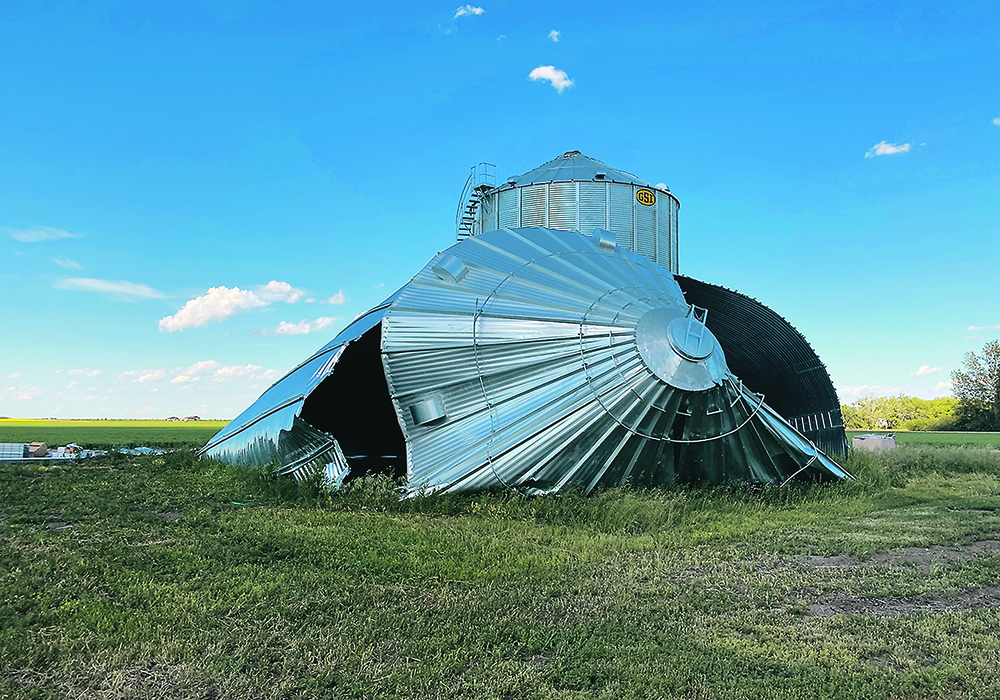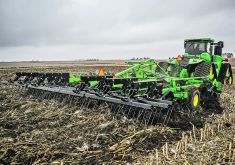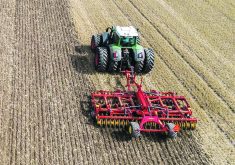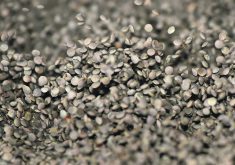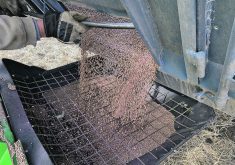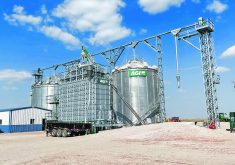Engineering and planning can save grain storage bins from wind damage, but sometimes the only options are insurance or possibly repair.
Early evening, Aug. 13, Kelvington, Sask: A 160 km/h wind ripped through Betty Clark’s bin yard and destroyed a dozen bins with an estimated replacement value of 1.2 million dollars.
Two bins remained undamaged, but the blast also took out the shed and electrical building.
Preparations for harvest were just beginning that evening. It was a mess. But it could have been worse.
Clark follows the agricultural news to keep abreast of factors that might affect her farm. While studying steel price trends last year, it became obvious her bins were not insured for replacement value. So, she visited her insurance broker, Steve Moulding, owner of Insurance Matters in Kelvington, Sask.
Read Also

Agri-business and farms front and centre for Alberta’s Open Farm Days
Open Farm Days continues to enjoy success in its 14th year running, as Alberta farms and agri-businesses were showcased to increase awareness on how food gets to the dinner plate.
They evaluated the bin assets, then bumped coverage up to replacement value, a move for which she’s now grateful. Moulding put the Aug. 13 claim in motion, along with hundreds of other claims from the 2022 summer. Crews arrived and began removing scrap metal to get ready for her new bins.
As you read this story, the new bins have been delivered and are being erected by Wall Grain Handling Systems of Winnipeg.
The entire project is expected to be wrapped up by Sept. 23. Harvest will experience only a minor glitch.
“There are many factors in windstorms,” said Dave Wall after visiting the Clark devastation. “Full bins don’t get damaged as long as the roof stays on. East-west rows seem better than north-south rows. A better sheltered yard and yard location reduces wind damage. But bins get built all over the place, so get the necessary insurance.”
In a phone interview, Moulding said that in the past year some bins have gone up 50 percent in price. Replacing a bunch of bins that are only insured for their original value will really hurt.
“Even bins that were purchased this past winter have increased as much as 50 percent. If you haven’t reviewed your bin insurance in the past couple years, all your numbers will be way out of the ballpark. Everything has changed with the global environment we’re in right now,” said Moulding, adding that a farmer should do a complete review of all insurance every year.
He handles four insurance companies, so customers can make comparisons.
He said the premium on galvanized steel bins is reasonable. Pole barns and other framed structures made of wood don’t last as long and they burn. Bins last and they don’t burn, and that is factored into the premium formula.
“The lifespan of a bin is much longer. If a bin is bolted to concrete or anchored with screw anchors, that’s reflected in a lower premium. If the bin is sitting on skids, it’s more susceptible to being brought down by wind.
“Premiums on a tall bin anchored to concrete would run about $3 per $1,000 per year. If it’s portable on skids, the premium will double. You’ll pay $6 per $1,000. That’s all based on documented risk factors. Also, grain bins don’t depreciate in value as quickly as other structures. Typically, one percent or a percent and a half annually is all.
“Premiums are based on the value of the insured item, and those items are increasing in cost almost monthly because of the global situation.
“It doesn’t matter if you’re building a grain bin or a new house or a doghouse, premiums reflect the rise in construction costs. We just hope this hostile environment will come to an end soon.”


